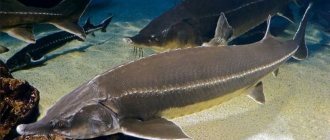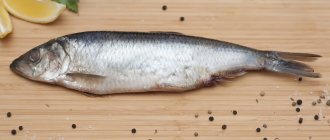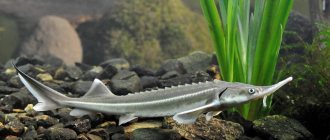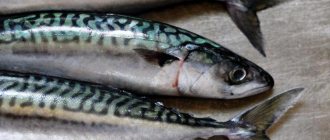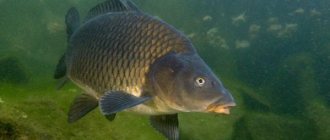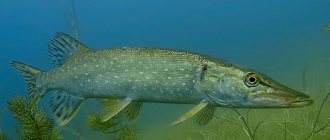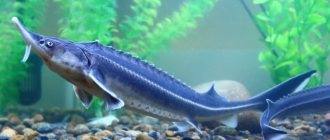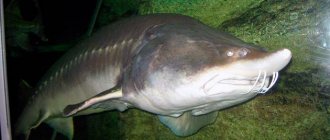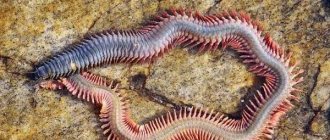Bloodworm
- a red worm - the larva of a long-legged mosquito - is the favorite bait of anglers when catching roach, dace, podust, ruffe, etc. In general, almost all fish take bloodworms greedily: bloodworms are visible from afar, and the red color is especially attractive to fish and, in addition, fish finds familiar prey in it. Bloodworms are found at almost every time of the year, both in rivers and in ponds, but more often in the latter, since they live in silt, from which they are extracted by scooping out the silt with sieves and other similar equipment and then washing them.
Content
- 1 Bloodworm habitat
- 2 Methods of obtaining bloodworms 2.1 How to find bloodworms
- 3.1 How to preserve bloodworms in winter
- 4.1 Tips for fishing with bloodworms
- 5.1 Hanging bloodworm
- 7.1 Advantages of artificial bloodworms
Bloodworm habitat
- Large bloodworms
- the main places of mass production are freshwater swamps and lakes with a large amount of bottom organic sediments, gauging ponds, and occasionally, if there is enough food, found in rivers.
- Small Ural bloodworms
, just like large bloodworms, are caught in freshwater lakes with large deposits of bottom organic matter.
- Small river bloodworm
- lives in freshwater rivers, streams and ditches, reaching the highest concentrations in places of industrial discharges.
- Southern Estuary
- lives in salty estuaries, with large deposits of bottom organic matter.
Bloodworm: basic facts
Chironomus plumosus is one of the most common mosquitoes in our region. The larvae of this insect are bloodworms. The answer to the question of whose larva is the bloodworm, the photo provided in the article illustrates most colorfully.
The larvae, semi-submerged in the muddy bottom of the reservoir, linger there, feeding on the organic component. Processing particles of sludge with the help of the salivary glands, the larvae glue it into special tubes, which are later used as a cocoon, from which the bloodworm protrudes only the head end to perform the feeding function. The habitats of larvae hatched from the eggs of a female mosquito include:
- ponds and ditches with standing water;
- ponds;
- silted lakes;
- saltwater estuaries.
Methods of extracting bloodworms
A device for collecting bloodworms from ice in winter. It is necessary to search for bloodworms in swampy, heavily silted and shallow water bodies. There are several ways to obtain bloodworms
.
- Method one:
To obtain larvae using this method, you will need several devices, one for raking up sludge, for example a scoop with a long handle, special nets with hard rims or a shovel with a long pole; you can also use an ordinary bucket with holes drilled in the sides and bottom. The main thing is that with this device you can easily scoop up sludge from the bottom. A second device is necessary for washing the bloodworms from silt, for example, a sieve or special landing nets - buckets with a fine mesh, a drilled bucket is also suitable. And the third device is a tray with water, which can be washed in the reservoir itself, it is especially convenient to do this in winter, in an ice hole.
So, using a scooping device, they scoop up sludge from the bottom of the reservoir, then pour the collected sludge into a lattice cassette or sieve, and lower this sieve into a pan of water. Using sharp movements to the sides, wash the sludge out of the sieve. Then the sieve is raised above the water for a few seconds and lowered into the water again, due to this the bloodworm dries out a little and floats to the surface of the water in rings. Now all that remains is to collect it with a net.
- Method two:
This method is more primitive, but also much easier. The second method requires a long-handled fork and thin metal wire. The fork teeth are bent at right angles, and wire is wound around them so that horizontal rows are formed 7-8 cm apart. With this device they row along the bottom of the reservoir, and thus hook the bloodworm larvae onto the wire.
- Method three:
Scoop up the mud and water using a bucket and place it near the fire. The larvae, feeling the warmth, will begin to float to the surface of the water, and all that remains is to collect them with a net.
- Method four:
For this method, take a metal liter can, from canned food or paint. Holes are made along the entire bottom of the jar, and two more are made on top to secure the bracket with the pole. This device is lowered to the bottom of the reservoir and rotated several times so that it is filled with silt. Then they lift the jar and keep it 2/3 in water so that all the silt is washed out and flows out through the holes in the bottom. The washed bloodworm larvae should remain in the jar.
- Method five:
The slowest. A piece of meat or fish is wrapped in a gauze bag and, together with the cargo, is sent to the bottom of the reservoir, having previously been tied with a cord. The next day there will be a lot of larvae in this bait.
How to find bloodworms
There is only one way to find out whether a pond is suitable or not - to try to wash bloodworms.
Check the recesses. The bloodworms are not scattered in an even layer over the entire bottom - they usually collect in the depressions. Sometimes this is only 1–2 m2 in area. There are few bloodworms in the areas of the bottom between the depressions. You might think that there is just as little of it in other places. But check the recesses and you'll find what you need. First try to wash the bloodworms in several places, and then decide whether the pond is suitable or not. Look for areas where the mud is soft and clean and free of algae, leaves, twigs and rocks.
A swarm of mosquitoes above the surface of the water should lead you to believe that there are bloodworms here. But this does not mean that if there are no mosquitoes, then there are no bloodworms either.
Direction of the wind.
Often on ponds the wind blows in the same direction and knocks insects to one of the banks. Check these areas first.
Temperature change.
In summer - when the water and silt are warm enough - the bloodworm lives at a depth of several centimeters from the bottom surface. When the temperature drops, it goes deeper. In winter, you need to look for it at a depth of 30 cm, or even more.
How to get bloodworms
The largest number of mosquito larvae in the natural environment can be found in the silt of lakes and ponds, abundantly overgrown with bottom vegetation. They are also found in flowing bodies of water. Having determined the habitat, it is easy to wash bait for fish yourself.
The easiest way to do this is to use a fine sieve in which the bottom silt is rinsed. The soil is carried away with the water, and the larvae remain on the sieve. They are easy to collect with a fine-mesh net. Getting bloodworms will not be an insurmountable problem if you use a fork with a long handle and a thin metal wire wound around the teeth. It is tied with horizontal lines at intervals of 6-7 centimeters. By raking the constructed device along the bottom of the reservoir, you can easily catch mosquito larvae.
To learn more:
Advantages of silicone predator baits
The third method of extraction is even simpler - the silt is scooped up with a bucket and placed near a hot fire. Feeling the warmth, the bloodworm will float to the surface from which it is collected with a net.
The slowest, but quite effective method of obtaining larvae is to lower pieces of meat or fish wrapped in a gauze bag and loaded with heavy cobblestones to the bottom of the reservoir. In about a day, the trap will have a lot of bait.
How to wash bloodworms is up to each hunter to decide for himself. And to separate small specimens from large ones, just put them in a fine sieve and lower them into a container of water. Large prey will remain on the mesh, and small fry will leak out along with the liquid.
Storing bloodworms
Storing bloodworms in potatoes
- For short-term storage (up to a day),
it is enough to dry the collected bloodworms for 15-20 minutes. in the air, scattering it on newspaper, after which the larvae will become brighter and more mobile. Then they need to be placed in a box made of any material with holes for ventilation, lined with a slightly damp, lint-free cloth. For longer storage (up to 5 days), the box should be wooden or foam. The bloodworm also tolerates the same period of time in large tubers or fruits (zucchini, cucumber, potatoes, etc.), from which the top is cut off and the core is scraped out. As a humidifier, you can pour some sleeping tea into it, and to prevent the bloodworms from sticking together, you can sprinkle it with starch. The cut off top will serve as a lid, which can be secured with toothpicks, matches or wires.
The bloodworm “pie” is stored for a week Spread a thin layer of bloodworms mixed with drunken tea and scraps of paper on one half of the flap, and cover with a damp sheet of paper. Up to 3 layers of this kind are made and the finished “pie” is covered with the second half of a piece of burlap. All this stuff is stored in the refrigerator in the summer, and on the windowsill, near the balcony door, etc. in winter. Every 2-3 days, the burlap must be rinsed and the bloodworms dried.
- For 2 weeks,
bloodworms are perfectly stored in a nylon stocking, placed in a container with water, replaced after 2-3 days, or in a drain tank (though if the water is not chlorinated). Another option is to store it in a glass jar, which is half filled with clean snow, a layer of bloodworms is poured, snow is added on top and placed on the bottom shelf of the refrigerator. Periodically, melt water needs to be drained and snow added.
- With the onset of autumn cold weather, the hassle of storing bloodworms completely disappears. It can be stored perfectly for up to 2 months
simply in a bucket of water (possibly with sludge) placed on the balcony. Just remember to remove the bucket from the balcony during severe frosts.
- To store bloodworms for more than 3 months,
you will have to freeze them. For the convenience of further use, the bloodworms need to be sorted, placed in matchboxes, bags or other suitable containers, and then placed in the freezer.
How to keep bloodworms in winter
- At home
They sort through the bloodworms, throw out the dead larvae and everything foreign - garbage, shells, white thread-like worms, etc. Place the bloodworms on a half-folded sheet of newspaper, generously moistened with water, and wrap it in an envelope. To prevent the larvae from feeling cramped, rolls of wet newspaper are placed inside the envelope. Make two or three more such wrappers on top and place the bundle in a cool place - at the very bottom of the refrigerator or between the window frames. Once every two days, the bloodworms are sorted out and the dead larvae are thrown away. Newspapers change. This way you can keep the bait alive for several days.
There is another way. The bloodworms are placed in a shallow baking tray filled 1-1.5 cm with water - the dead larvae float to the surface. The bloodworm lives for one and a half to two weeks.
Bloodworms are stored in a special cassette (sold in pet stores) for up to a month. You just need to change the water daily and wash the cassette with warm water and soap once a week.
- Fishing
The bloodworms are stored in a wooden (preferably in foam) box wrapped in a damp cloth. If the frost is severe, the box is kept behind the lapel of a sheepskin coat.
When placed on a hook, the bloodworm naturally dies, and yet the fish takes such a bait. Therefore, during severe frosts, you can deliberately freeze bloodworms by scattering them near the hole. It is easier to put a frozen bloodworm on a hook; you just need to warm it slightly with your breath. The bloodworms completely thaw in water.
How to keep bloodworms in summer
In ancient times, residents of hot countries cooled water in vessels made of porous clay... in the sun. Penetrating through the walls of the vessel to the outside, a small amount of water evaporated, and the vessel itself cooled greatly. This physical phenomenon - loss of heat through evaporation - can be used to preserve perishable baits (and especially bloodworms) when fishing during the hot season.
The bloodworms are placed in a metal jar, in the lid of which holes are made for air, and, wrapped in a wet rag, they are kept in the wind. As the rag dries, moisten it. When taking the next portion of bloodworms for attachment, the jar is immediately closed, protecting it from heating. In this way, bloodworms can be kept alive for one to two days.
How to properly store bloodworms for fishing at home
You can store bloodworms at home in a jar of water in the refrigerator. It is better to take a wide jar, so that the larvae cover its bottom with a layer of no more than one centimeter. Once every three to four days it is necessary to change the water, and once a week - to remove dead larvae. To do this, you need to transfer the bloodworms into a sieve, lowered into a container with water at room temperature: the live larvae will move from the sieve into the container itself. It is worth noting that if bloodworms are properly stored at home, the percentage of bait death will be almost zero
.
The temperature in the refrigerator should be no more than +5 °C, as this is the easiest way to keep bloodworms alive longer at home. In this way, larvae can be stored for several months.
.
The following video describes how to store bloodworms at home for as long as possible. The method is similar to the one above, but with a few subtleties that will require a little extra manual work. We hope this video will help you keep the larvae alive:
Groundbait bloodworms can be stored in the freezer.
Fishing with bloodworms
Fishing bloodworms are catchy baits that are used by almost all types of fish. But for installation it requires gentle handling, which involves the use of light and sensitive equipment. For fishing for a single larva, thin hooks No. 20...28 are often used, for a bunch - No. 16. They are tied to leashes of 0.05...0.12 mm - depending on the time of fishing and potential prey. When fishing for bloodworms, the float should be well weighted - only its antenna should be left above the surface of the water. Such a signaling device will allow you to notice even the most careful and gentle bite. Large bloodworm
, which is used as bait, is stored in cold, clear water. If you change it often, the larvae remain alive for a long time and squirm when placed on a hook. Small bloodworms are usually used by fishermen as bait or as part of a bait mixture. In the latter case, larvae should not be added in large quantities. After a short time, due to the presence of sweet components, they die.
Tips for fishing with bloodworms
- The hook on which you are going to attach this bait should be made of thin wire. The thickness of the wire is determined visually.
- The bloodworm must be fresh. You can determine the freshness of bloodworms by observing them. Fresh bloodworms almost always have a bright (most often bright red) color. It moves actively and glistens in the Sun. Stale bloodworms quickly darken.
- After each bite (successful or not), this larva must be changed.
- Bloodworm is a delicate bait. Any mistake when placing this bait leads to damage to the bloodworm.
- Bloodworms are considered such an attractive bait that many are confident that the mere presence of bloodworms or a bunch of bloodworms always leads to a bite. This is mistake. The bait on the hook should look natural, should not “leak out”, and, if possible, hide the hook tip.
- The most attention of the fish is attracted by the moving bloodworm, therefore the most effective bait is considered to be a “sandwich”, which includes a bloodworm (a bunch of bloodworms) and one (two) maggots.
Features of the body
The body of the larva is worm-shaped with a bright red or ruby color. The bright reddish tint that the bloodworm has (whose larva it is is now clear) is due to the filling of the body with blood with high hemoglobin. This is a natural source of iron, which serves as a tool for retaining oxygen in the body. Thanks to this, the larvae are able to survive in an environment deprived of oxygen.
The respiration of a mosquito at the larval stage is carried out using thread-like gill appendages, which are located throughout the body of the bloodworm. Whose larva, breaking out into the water column, quickly moves through mechanical twisting of the body? Of course, only one insect. This, by the way, is where the name “bloodworm” comes from - the future mosquito simply dangles in the water.
The larva actively develops under favorable climatic conditions and appropriate temperature conditions. If there is an abundance of food, after two weeks the larvae hatching from the eggs can reach a size of 15-17 mm. After maturation, a large bloodworm, whose larva pupates, rises to the surface of the water, where adult mosquitoes hatch from the pupae and fly into the air.
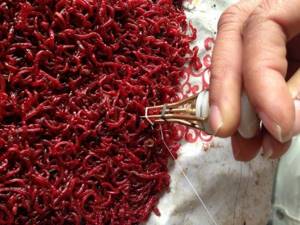
Methods of planting bloodworms
- The first thing
you should pay attention to when fishing for bloodworms is the hook itself. Here you should use thin and sharp hooks for bloodworms, otherwise the bloodworms will leak out. Select the bend and point of the hook without burrs or burrs, and the barb should not move too far to the side. - Second,
since fresh bloodworms are always wet, the bloodworms should be taken with dry hands so that they do not stick to your fingers. - Third,
handle the bloodworm gently, otherwise it will be easy to crush.
Using these three rules
, the bloodworm will never flow out after being attached to the hook.
Hanging bloodworm
For especially medium-sized perch, small bloodworms are used and one or two pieces are attached. If the fish is active, then the number can be increased to two pieces on the hook.
Choose a medium-sized bloodworm - the small ones go to feed. Place the bloodworm on your finger, a jig, or take it with two fingers of your other hand and carefully pierce the bloodworm into the second or third segment at its head with the tip of the hook. The bloodworm hangs by a thread from the hook, dangles freely when playing and repeats the movements of a living bloodworm. A properly mounted bloodworm retains its vitality for up to 10 minutes, attracting and seducing surrounding fish. Used when catching active fish. It is not necessary to hide the hook tip, as experience shows that this does not play any role.
This method is good for everyone and for fish such bait resembles a natural bloodworm, it is easier to capture. But, if the perch is small, the fish is sluggish and only nibbles the bloodworm, and does not capture it entirely, then you have to resort to various tricks, and the simplest one is to plant it in a ring.
Bloodworm with a ring or stocking
Bloodworm ring
Under natural conditions, bloodworms are often found rolled into a ring, and fish often see them in this form. There are two methods that differ from each other, but can remind the fish of a natural bloodworm in this form.
In the first case, you need to take the hanging bloodworm by the back and pierce it with the sting of the hook, forming a ring. The bloodworm is secured with a sting at both ends. When playing, it moves quite well, but its length decreases and its size remains the same. It becomes more difficult for fish to pick such bloodworms, but easier to capture. With passive biting and small fish size, this method will help us out when fishing.
Bloodworm stocking
In the second case, the bloodworm is impaled with a stocking. The sting is also inserted into the second or third segment at the head, but is not withdrawn, but is carefully placed on the hook with light movements all the way to the forked tail of the bloodworm. With this method, the fish will not have a chance to pull the bloodworm's tail with impunity.
If you catch bleak, but there are no small bloodworms, but only large ones, used for catching roach, bream and perch, then catching the bleak is problematic, as it will only nibble it. If fishing is fast, then you need to cut the bloodworm so that the juice flows from it. This bait is suitable for fish, such as bleak or small perch, that are in an active state at shallow depths, when the juice from the bloodworm does not have time to flow out. But it’s still better to use a full-fledged, but small bloodworm.
Method of planting bloodworms across
There is a way to plant bloodworms across. Often used when fishing for roach. The bloodworm is placed not by the head, but by the middle. The bloodworm also remains alive and moves beautifully. This method of placing a bloodworm on a hook is very good for playing on the lowering. Performing a smooth movement with a well-tuned nod, the bloodworm makes smooth oscillatory movements in the water column with both ends, attracting roach.
Method of attaching bloodworms in a bunch
This method is used when catching large fish, with active biting, or when catching white bream or silver bream, which prefers large bait. A bunch can be formed from any number of bloodworms, placing 2-3 pieces per hook by the head and ending with up to a dozen if the bite is active and the fish is of a good size. To catch roach, spring perch or perch on the first ice, 2-3 are enough. But a bunch of bloodworms, with their appearance, can attract large fish, like bream. Therefore, if you are catching large fish, then do not hesitate to add more bloodworms. In any case, a bunch of bloodworms secrete juice, and a considerable amount.
Sometimes a conical tube is used to attach a bunch of bloodworms to a hook. In this case, a thick, clean fountain pen refill will also help. One or two rings of nipple or other elastic are placed on the tube and moved after the next portion of bloodworms. The elastic ring is hooked. The bloodworm is not damaged and remains alive for a long time, attracting large and active fish.
When arriving at a pond, usually attach two small bloodworms, expecting active play, and then adjust the situation by increasing or decreasing the number of baits depending on the activity and bite of the fish.
There are other ways to attach bloodworms, but they are more nuanced. These types of baits are quite sufficient for any type of fishing.
Feeding aquarium fish
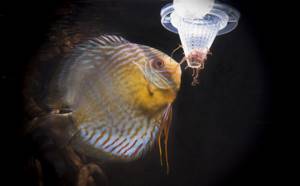
Bloodworms have always been considered the best live food for adult fish. When purchasing this food, you must carefully inspect it. It should be red, but not scarlet. Bright red bloodworms usually do not last long. It should be elastic, move when touched and lie separately, curl into a ring.
You cannot feed dead bloodworms to fish, as they can easily be poisoned. Freshly caught fish are also not suitable for feeding fish. It is necessary to withstand it for 2-4 days to cleanse the intestines, which may contain pathogenic flora of local reservoirs. During this period, the water in which the larvae are located must be changed periodically.
Store it in a cool place at a temperature of 4-8°C, for example in the refrigerator. If you have a large amount of bloodworms that cannot be kept alive for long, you can freeze them. The best way to do this is to spread it in a thin layer on plastic film, to which it does not stick. When it freezes, break the resulting pancake into pieces, put it in a plastic box and put it in the freezer.
It is recommended to feed adult aquarium fish with bloodworms using a floating feeder with holes in the bottom, through which live bloodworms gradually crawl into the water. This does not give him the opportunity to bury himself immediately in the ground. But my fish caught buried bloodworms and even pupae that emerged before the mosquitoes appeared. I did not like the recommendations to feed small aquarium fish and grown juveniles with bloodworms cut with scissors on glass. Everything flows out of the bloodworm, leaving only skins that are of no value. But this method works with the tubifex.
Video
Bloodworm breeding
Red (up to 2.5 cm) bell mosquito larvae are cultivated using a rather complex technique. For this purpose, a uterine swarm of mosquitoes is created and maintained. It is kept in a bright room at 18-20° C. Eggs and mosquitoes are laid in ditches with water.
From there, the clutches are selected and incubated in trays, which are placed in vertical risers to save space. The larvae are raised on a yeast diet for several days after hatching, and the cycle lasts 15 days if the temperature is maintained at about 22°C. Daily production reaches 25 g/m2 of usable area.
Mosquito larvae are stored for a long time at a temperature of 4-8° C in a slightly damp linen cloth. You can mix them with dried tea leaves. The bloodworm remains alive in running cold water for up to a month.
Where to buy bloodworms?
Bait is not difficult to find. Pet stores are full of such goodness. If you want to purchase a quality product, then it is not advisable to engage in bloodworm extraction yourself. The bait must undergo special treatment: disinfection and cleaning. This is a labor-intensive and technologically complex process that requires special training.
Bloodworms are a carrier of pathogenic organisms, so it is important that the feeding is special and, most importantly, properly processed. Unfortunately, even in pet stores there are a lot of low-quality bloodworms, so when choosing fish food, go only to well-established ones. It is best to choose not fresh, but frozen bloodworms that have undergone special processing when it comes to fish food. Fresh larvae are also suitable as bait.
Source: fb.ru
animals, nature
Artificial bloodworm
Artificial bloodworms Artificial bloodworms
are an imitation of mosquito larvae. This bait is not very popular. Artificial bloodworms are effective when catching perch.
Artificial bloodworm
- one of the most famous baits. Almost every fishing store sells it. With some effort, you can find this bait of decent quality in stores. Such bloodworms are similar to real larvae in their color and shape. It can even be confused with living larvae.
Some artificial bait manufacturers impregnate their products with various scents. There are baits with the smell of anise, hemp or vanilla. The choice is huge. But the fish prefers a natural product! Still, this bait should be in the winter fishing box. An artificial imitation of a larva can sometimes help out during winter fishing.
Benefits of artificial bloodworms
- Artificial bait is always available in stores. Natural bloodworms are a seasonal product; they are not available for sale in the fall and summer.
- And who hasn’t had bloodworms freeze in the cold when moving from hole to moon? In this case, you have to break the ice bloodworm with frozen fingers and literally scrape the remains off the hook. A frozen bait simulator very quickly thaws in the water and continues to deceive the fish.
- Delicate natural bait holds relatively weakly on the hook. After almost every bite it is necessary to add fresh bloodworms. Yes, and planting bloodworms in the cold and windy with your bare hands is not a very pleasant experience. The bait simulator holds perfectly on the hook and it is quite difficult for the fish to break it.
- Storing natural bloodworms is a labor-intensive task. In heat it deteriorates very quickly, and at low temperatures it freezes and dies. Even with ideal storage, bloodworms live no more than three weeks at home. The substitute can be stored even for several years without damage. No special conditions are required for its storage.
These are the undoubted advantages of artificial bait. A significant disadvantage is that fish are less willing to bite on bait.
How to attach an artificial bloodworm to a hook?
In severe frosts, when fishing for perch, it is most rational to use artificial bait with several maggots. First, a couple of imitators are attached, and a maggot is placed on the very tip of the hook. With this method, you can catch several perches without changing or replanting the bait.
A good effect is obtained when attaching an artificial bait to a hanging hook. It is advisable to constantly play with a jig. The bait will oscillate, reminiscent of the movement of a live bloodworm.
By the way, there is no need to look for supernova bait in stores. When fishing for perch in winter, it is often enough to hang a red thread on a hook. Experienced fishermen sometimes put several rings of red insulation on the hook. The perch readily grabs such a bait.
Another way to quickly make bait: cut a child’s balloon into narrow strips. If you attach one or two strips to the hook of a spoon, the bite will improve significantly. This method has been tested and used successfully.
Larva as the main fish bait
Bloodworms are an excellent bait for river fish and the basis of food for aquarium fish. A fisherman who has equipped his equipment with such bait as bloodworms is doomed to successful fishing. Larger dark ruby bloodworms are suitable for fishing, but smaller individuals are used as food. But some species of fish still disdain such bait/food as bloodworms caught in a saltwater estuary. The most common basis of the diet is river larva, which is suitable for all types of fish without exception.
Red bloodworms, whose larvae are rich in hemoglobin, are an excellent food for aquarium fish. By including such a product in your diet, be sure that the fish receives a full range of essential minerals and vitamins, especially iron, in one feeding.
